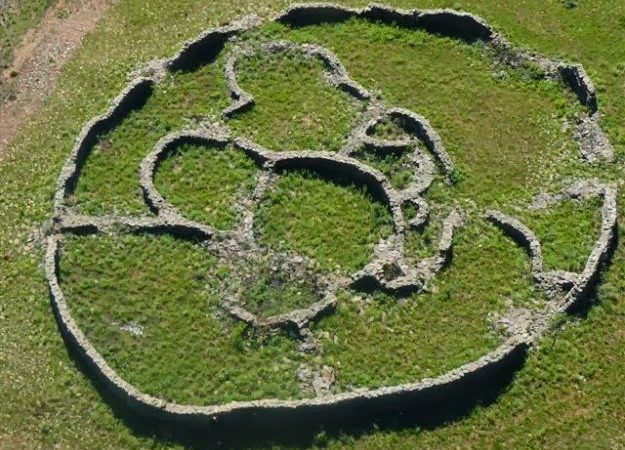There are many many structures that built before the architecture of the Greeks and Romans in ancient Africa, these are just six of them.

South African Ruins
The recent discovery of an ancient circular monolithic stone structure site in Mpumalanga, South Africa, is thought to be at least 75,000 years old, pre-dating any other structure on earth, according to South African author and politician Michael Tellinger.
Tellinger estimates that there are well over a million ancient stone ruins scattered throughout the mountains of southern Africa. Various tools and artifacts that have been recovered from these ruins show a long and extended period of settlement that spans well over 200,000 years.
The most spectacular example of these ancient ruins is called the Adam’s Calendar, claims Tellinger. This spectacular ancient site is aligned with the north, south, east and west cardinal points, solstices and equinoxes. It is still an accurate calendar although it has been dated at least 75,000 years of old, based on scientific evaluations, according to the author.
The calendar was reportedly rediscovered by pilot Johan Heine in 2003, and named by Tellinger as Adam’s Calendar because it is possibly the oldest structure on earth that is linked to the human species.

The Step Pyramid
Built in ancient Egypt (Kemet or Kmt) in 2667–2648 B.C., the Step Pyramid, or The Pyramid of Djoser, was the first stone building in history and the first of the many pyramids to appear during the following 1,000 years. The Step Pyramid was a tomb for third dynasty Pharaoh Djoser and members of his family, designed by Imhotep, the first known architect, engineer, and physician in early history.
The structure started off as a mastaba tomb — a flat-roofed building with sloping sides — and, through a series of expansions, evolved into a 197-foot-high (60 meters) pyramid, with six layers, one built on top of the other.
According to Livescience.com, the pyramid was constructed using 11.6 million cubic feet (330,400 cubic meters) of limestone and clay. The tunnels beneath the pyramid form a labyrinth of about 3.5 miles (5.5 kilometers) long.

The Temple Complex of Karnak
The temple complex of Karnak is one of the most impressive sites in all of Egypt and it’s the largest religious compound ever built by man. Karnak is actually the site’s modern name. Its ancient name was Ipet-isut, meaning “The Most Select (or Sacred) of Places.”
Construction work began in 16th century B.C. and continued past the era of Pharaoh Ramses II, from approximately 1391-1351. The complex consists of four main parts, the Precinct of Amon-Re, the Precinct of Montu, the Precinct of Mut and the Temple of Amenhotep IV (dismantled).
These magnificent structures represent the combined achievement of many generations of builders in ancient Africa. Approximately 30 pharaohs contributed to the structures, enabling it to reach a size, complexity and diversity not seen elsewhere.

The Great Sphinx of Giza
The Sphinx of Giza is one of the largest and most recognizable statues in the world. The half-man, half-lion colossus of stone was sculpted 4,500 years ago (c. 2558–2532 B.C.), although some researchers date it thousands of years older than that.
The statue, with the body of a lion and the face of a man, is said by some Egyptologists to have been created in the image of 4th dynasty Pharaoh Khafra.
It is the largest monolith statue in the world, standing 241 feet (73.5 meters) long, 63 feet (19.3 meters) wide, and 66.34 feet (20.22 meters) high.

Pyramids of Giza
Pyramids of Giza are the three fourth-dynasty pyramids (c. 2575 – c. 2465 BCE) erected on the rocky plateau of the west bank of the Nile River near Al-Jīzah (Giza) in Egypt. The structures were built as burial tombs for three fourth-dynasty pharaohs, Khufu, Khafre, and Menkaure, and are named after each king respectively.
The Great Pyramid is the northernmost and oldest of the group. It was built for Khufu, who was the second king of the fourth dynasty. The edifice is the largest of the three, with the length of each side at the base averaging 755.75 feet (230 meters), and its original height towering at 481.4 feet (147 meters).

Nubian Pyramids and Temples
Between 1500 and 1085 B.C. Egyptian conquest and domination of Nubia was achieved. This conquest ushered in the Napatan Phase of Nubian history, the birth of the Kingdom of Kush. During this phase there were numerous pyramids and temples erected.
Nubia, which was known as Kush and is modern-day Sudan, rivaled its neighbor Egypt in wealth and power, and both empires mutually influenced each other. Nubia has 223 pyramids, twice the number in Egypt. Prior to the Kushites building their pyramids, there had been no pyramid construction in Egypt and the Nile Valley for more than 500 years.
Source: Atlanta Black Star

































Leave a Comment
You must be logged in to post a comment.